Leather legacy fades
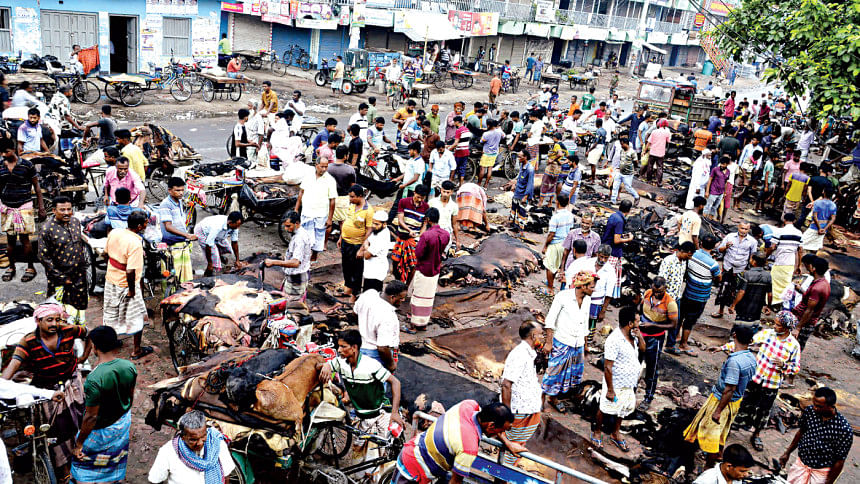
As the sun dipped below the horizon on Eid-ul-Azha, the narrow rural roads of Kalidasgati stirred with life. Mini-trucks and auto-vans rolled into the village, laden with the pungent, freshly flayed cowhides of the day's ritual sacrifices.
Traders, including seasonal operators, small-scale middlemen, and longtime associates, headed to the yard of Aminul Islam, a veteran hide merchant whose family legacy now teeters on the brink of collapse.
From dusk until the following day, the village buzzed with activity. Knives scraped, labourers shouted instructions, and hides were trimmed, salted, and stacked with mechanical rhythm under Islam's watchful eye. At 59, he moved with the ease of someone who had grown up in the trade.
"I've been in this business for over 35 years," he said, wiping his brow, hands dusted with salt. His father and uncle once ran a shop in Sirajganj's Chamra Potti, then a thriving hub with over a hundred traders.
"Now, I'm the only one left. My cousins left the trade. There's no living in it anymore."
This Eid, Islam sourced over 500 cowhides, paying up to Tk 1,000 for top-quality hides. After processing, he hoped to sell them at Tk 1,400 to Tk 1,500. Yet, the process is fraught with risk.
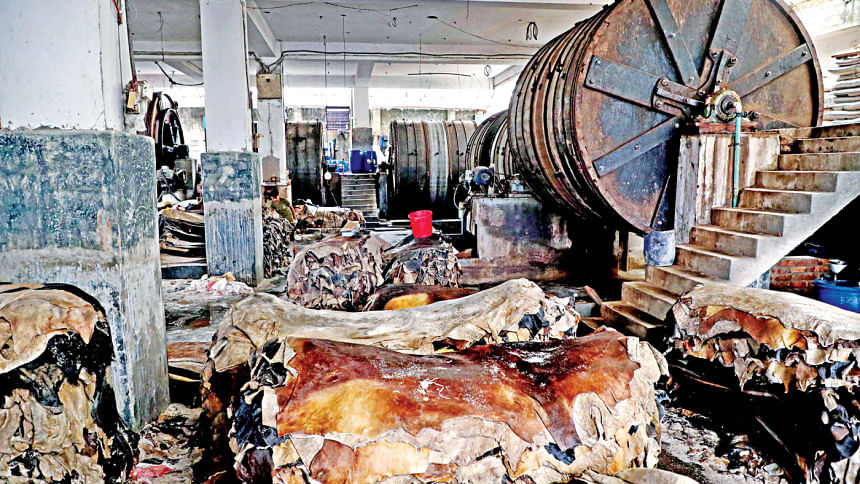
Despite his years of experience, turning a profit remains a struggle.
"There was a time when tannery owners paid in advance. Now, they vanish."
"We'd travel to Dhaka's Hazaribagh and Hemayetpur in Savar, stay for a week, and still return empty-handed or worse, with merely a token sum as pocket money," he said.
The rawhide trade was once a cornerstone of rural enterprise during Eid-ul-Azha, the festival of sacrifice for Muslims.
The proceeds from selling the skins of sacrificial animals were traditionally channelled to charitable causes, such as supporting the poor, the needy, and religious institutions like madrasas and orphanages.
Beyond these donations, the hides sustained the tanneries and leather exports throughout the year, forming a vital link in both local industry and global trade.
Islam remembers hundreds of traders in areas like Gandail-Noyapara and Garudaha. Today, most have abandoned the trade in search of more viable livelihoods.
He squarely blamed both tannery owners and the government for the decline of the once-thriving leather industry.
"No one is willing to reform the system. That's why the industry is dying," commented Islam.
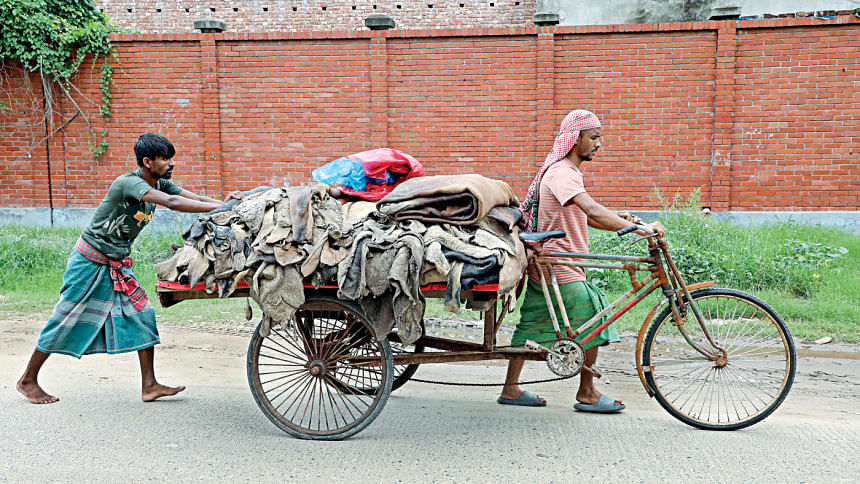
A NATIONWIDE CRISIS
The situation is the same across the country. Over the past decade, 21 tanneries in Chattogram have shut down, leaving only RIFF Leather Limited, part of TK Group, still operating and obviously under major constraints.
Rawhide dealers have borne the brunt of the decline. With debts of Tk 12 crore piling up over the last four years and fair prices increasingly out of reach, their survival is at stake.
In Dhaka, cow and buffalo hides sold for Tk 650 to Tk 800, while in rural areas, prices slumped to Tk 400 to Tk 500. Goat skins have become even harder to sell due to a lack of buyers.
Seasonal traders say the government sets prices for salted hides but not for raw hides still bearing flesh and blood. This pricing gap has led to unfair practices and a steady erosion of the seasonal trade. Many people now choose to donate hides to mosques, madrasas or orphanages, some of which need persuading to accept them.
According to the Bangladesh Hide and Skin Merchants Association and the Bangladesh Tanners Association (BTA), the sector includes about 100,000 traders and tannery owners. Yet a significant share of hides is collected by informal buyers and religious institutions and never enters the formal system.
This informal segment mainly handles unsalted hides, making it more vulnerable to pricing irregularities and mismanagement. As a result, complaints of unpaid dues and losses are common.
Eid-ul-Azha is the peak season for rawhide collection. This year, the industry hopes to gather between 80 lakh and 85 lakh pieces, meeting around half of the annual rawhide demand, according to BTA Chairman Shaheen Ahamed.
Bangladesh produces up to 80 lakh pieces annually, of which about 80 percent is exported. The country produces 400 million square feet of leather each year, but only 20 percent is used locally, underlining the industry's dependence on global markets.
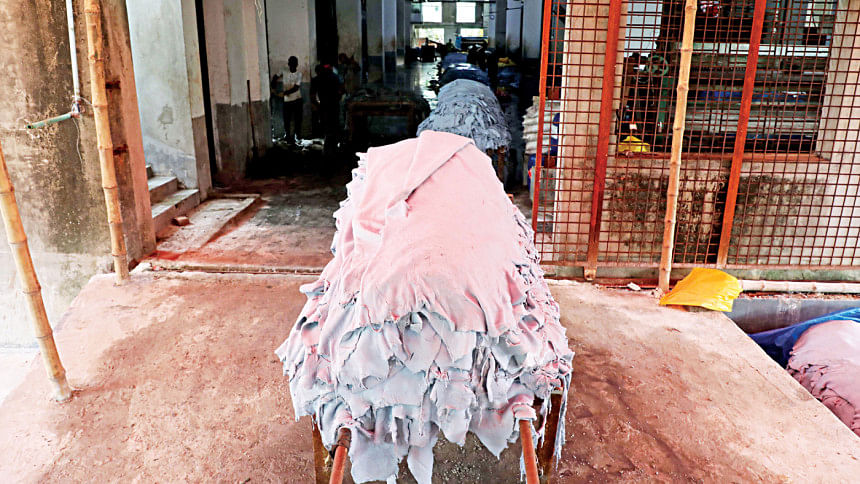
GOVT-SET RATES VS MARKET REALITIES
This season, the Ministry of Commerce raised the price of salted cowhide by Tk 5, setting rates at Tk 60 to Tk 65 per square foot in Dhaka and Tk 55 to Tk 60 outside the capital. This means minimum prices of Tk 1,350 in Dhaka and Tk 1,150 elsewhere. Salted goat hide was set at Tk 22 to Tk 27, and goat hide at Tk 20 to Tk 22 per square foot.
Large cowhides generally range from 31 to 40 square feet, medium from 21 to 30 and small from 16 to 20. Despite the price rise, raw and unsalted medium-to-large hides sold for Tk 700 to Tk 900 this Eid, with lower grades fetching only Tk 600 to Tk 650, similar to last year.
Salted goat skins sold for as little as Tk 20 to Tk 25 in some areas, barely meeting the official minimum price.
Tipu Sultan, general secretary of the Bangladesh Hide and Skin Merchants' Association, said rawhide was not being traded at the government's set rates anywhere. Medium and large hides sold for Tk 750 to Tk 800, he said, as a result of a liquidity crisis.
The government recently lifted a ban on exporting raw and wet-blue leather in an attempt to ease surplus and stabilise prices.
Commerce Adviser Sk Bashir Uddin acknowledged long-standing issues such as syndicates and outdated infrastructure.
He said he was travelling across the country to tackle malpractice and boost exports.
He also pointed to poor market knowledge among seasonal traders as a cause of price volatility during Eid.
However, many in the industry say efforts by the government have had little effect without strict enforcement.
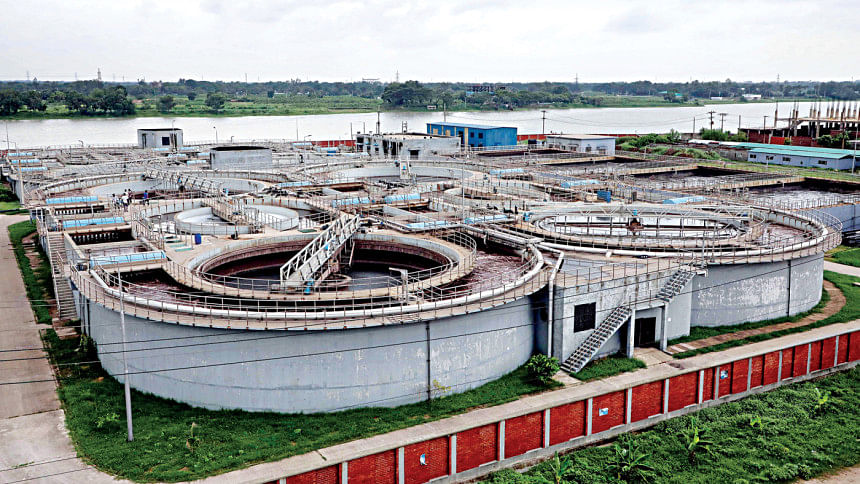
STRUCTURAL CHALLENGES AND GLOBAL CERTIFICATION
One of the biggest weaknesses of the leather industry is the incomplete relocation of tanneries from Hazaribagh area of the capital to the Savar tannery estate.
Although the relocation began in 2003 to address environmental concerns, the Central Effluent Treatment Plant (CETP) at Savar still does not function properly. As a result, untreated waste continues to pollute the Dhaleshwari River.
As a result, global buyers, especially those from Europe and North America, avoid Bangladeshi leather due to sustainability concerns. Chinese buyers have filled the gap, but they barely meet the official floor prices.
Asikur Rahman of Tajin Leather said Chinese importers often work together to keep prices low, offering just 40 to 60 cents, or Tk 60 to Tk 70, per square foot for medium to good quality hides.
No tannery in Savar has achieved international certification from the Leather Working Group (LWG), shutting Bangladesh out of premium markets.
LWG ACCREDITATION CAN DOUBLE LEATHER EXPORT
At a recent event, Syed Nasim Manzur, president of the Leathergoods and Footwear Manufacturers and Exporters Association, said LWG approval was essential for Bangladesh to regain major export markets.
He urged the government to appoint an internationally accredited operator for the treatment plant, provide green financing and offer the same policy support given to the garments sector.
With these changes, Manzur said, leather export earnings could double.
BTA chairman Shaheen Ahamed raised the same concerns.
He noted that while more than 140 companies operate at the Savar Leather Industrial Park, none meet international standards for environment and quality.
Without compliance certification, European and American buyers continue to turn to India and China.
Ahamed said another growing challenge was global demand for synthetic leather. Genuine leather boots might cost $150 a pair, while synthetic ones can sell for as little as $30 to $40.
"This is a key reason why leather exports from Bangladesh are not increasing," he said.
LEATHER EXPORTS IN DECLINE, SYNTHETICS ON THE RISE
According to BTA, exports of leather and leather goods have fallen steadily from a peak of $1.5 billion in the fiscal year 2016-2017 to about $980 million in the fiscal year 2023-2024.
Exports of leather goods, excluding footwear, have fallen to about $750 million. Orders from Europe have dropped sharply, pushing producers to sell to buyers who do not require compliance at lower prices.
Despite the abundance of local rawhide, local manufacturers ironically are now importing about $200 million worth of LWG-certified leather each year to meet global standards.
While leather exports decline, synthetic footwear is on the rise.
Exports of synthetic shoes rose by 30 percent in the first 11 months of the last fiscal year, reaching nearly $495 million, up from $380 million the previous year.
In May alone, exports shot up to almost $75 million, compared with $48 million in May 2023.
Riad Mahmud, managing director of Shoeniverse Footwear, said the demand for non-leather footwear was being driven by younger Western consumers who preferred affordable and fashionable alternatives. Synthetic shoes face fewer regulatory hurdles, giving Bangladesh an edge in global markets.
THE ROAD AHEAD
Professor Mohammad Kamruzzaman, director of the Institute of Leather Engineering and Technology at the University of Dhaka, said Bangladesh had lost its place in global leather markets mainly because of the lack of LWG certification.
According to him, poor rawhide preservation, unfair pricing, a failing treatment plant, and weak marketing have added to the decline.
He criticised government price policies for being set without proper consultation and warned of manipulation by syndicates.
Recently, Commerce Secretary Mahbubur Rahman said a rawhide storage shed would be built beside the tannery estate at Savar. There will also be similar facilities in Chattogram and Natore.
These are expected to help improve preservation and raise market value, he added.


 For all latest news, follow The Daily Star's Google News channel.
For all latest news, follow The Daily Star's Google News channel. 


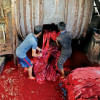


Comments